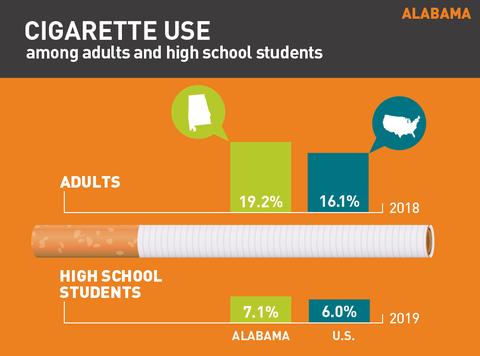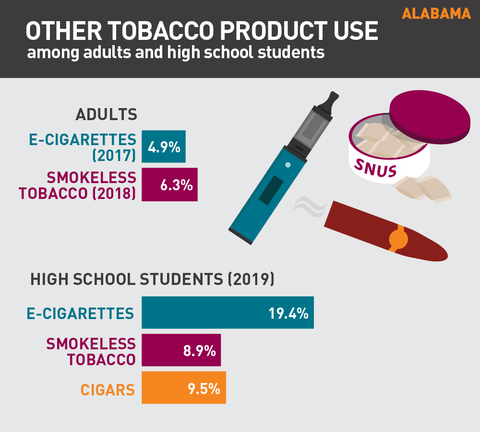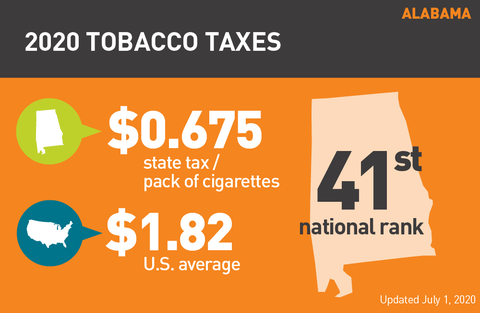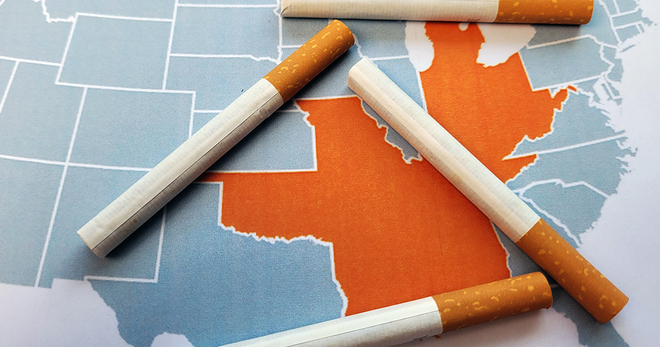Tobacco use in Alabama 2020
Cigarette use: Alabama*
Rates of cigarette smoking in Alabama
- In 2018, 19.2% of adults smoked. Nationally, the rate was 16.1%.1
- In 2019, 7.1% of high school students in Alabama smoked cigarettes on at least one day in the past 30 days. Nationally, the rate was 6.0%.2
Other tobacco product use: Alabama
What are the vaping rates in Alabama
- In 2017, 4.9% of adults in Alabama used e-cigarettes.3
- In 2018, 6.3% of adults in Alabama used smokeless tobacco.3
- In 2019, 19.4% of high school students in Alabama used electronic vapor products on at least one day in the past 30 days. Nationally, the rate was 32.7%.2
- In 2019, 8.9% of high school students in Alabama used chewing tobacco, snuff or dip on at least one day in the past 30 days. Nationally, the rate was 3.8%.2
- In 2019, 9.5% of high school students in Alabama smoked cigars, cigarillos or little cigars on at least one day in the past 30 days. Nationally, the rate was 5.7%.2
Economics of tobacco use and tobacco control
How much doe Alabama get from tobacco taxes
- Alabama received $300.1 million (estimated) in revenue from tobacco settlement payments and taxes in fiscal year 2020.4
- Of this, the state allocated $2.2 million in state funds to tobacco prevention in fiscal year 2020, just 4.0% of the Centers for Disease Control and Prevention’s annual spending target.4
- Smoking-related health care costs: $1.88 billion per year.4
- Smoking-related losses in productivity: $2.71 billion per year.5
Alabama tobacco laws
Alabama cigarette tax
Tobacco taxes
- Alabama is ranked 41st in the U.S. for its cigarette tax of .675 cents per pack (enacted October 2015), compared with the national average of $1.82. (The District of Columbia has the highest tax at $4.50 and Missouri has the lowest at 17 cents.) 6-8
- Chewing tobacco is taxed at 1.5 cents per ounce. All other tobacco products have varying taxes based on weight and price.6,7
Clean indoor air ordinances
- Smoking is restricted in all government workplaces, schools, childcare facilities, retail stores and recreational/cultural facilities.7
- Smoking restrictions are not required in private workplaces, restaurants, bars or casinos/gaming establishments.7
- The use of e-cigarettes is prohibited at licensed day care facilities and licensed emergency medical providers cannot use e-cigarettes while operating or riding in an ambulance or while providing patient care.9
Licensing laws
- Retailers and wholesalers are required to obtain a license to sell tobacco products.6
- A retail license is required to sell e-cigarette products. A county may not issue a license for sales of e-cigarettes if the retail business is located within 1,000 feet of a school, child-care facility, church, public library, playground or park, or other youth-centered facility or space after January 1, 2020 (unless the retailer is a specialty shop that has been in business at that location for 18 consecutive months).9
Youth access laws
- In December 2019, the United States adopted a law raising the federal minimum age of sale of all tobacco products to 21, effective immediately.
- Establishments are required to post signs stating that sales to minors are prohibited.6
- Minors are prohibited from buying electronic smoking devices, including e-cigarettes.6
Quitting statistics and benefits
Quitting smoking or vaping in Alabama
- The CDC estimates 56.2% of daily adult smokers in Alabama quit smoking for one or more days in 2018.3
- In 2014, the Affordable Care Act required that Medicaid programs cover all quit medications.7**
- Alabama’s state quit line invests $1.44 per smoker, compared with the national average of $2.14.7
- Alabama does not have a private insurance mandate provision for quitting tobacco.7
Notes and references
Updated August 2020
*National and state-level prevalence numbers reflect the most recent data available. This may differ across state fact sheets.
**The seven recommended quitting medications are NRT gum, NRT patch, NRT nasal spray, NRT inhaler, NRT lozenge, Varenicline (Chantix) and Bupropion (Zyban).
Fiore MC, et al. Treating Tobacco Use and Dependence: 2008 Update. Clinical Practice Guideline. Rockville, MD: US Department of Health and Human Services. Public Health Service: May 2008.
1. CDC, Behavioral Risk Factor Surveillance System, 2018.
2. CDC, Youth Risk Behavioral Surveillance System, 2019.
3. CDC, Behavioral Risk Factor Surveillance System, State Tobacco Activities Tracking and Evaluation System, 2020.
4. Campaign for Tobacco-Free Kids, Broken Promises to Our Children: a State-by-State Look at the 1998 State Tobacco Settlement 21 Years Later FY2020, 2019.
5. Campaign for Tobacco-Free Kids, Toll of Tobacco in the United States.
6. American Lung Association, State Legislated Actions on Tobacco Issues (SLATI).
7. American Lung Association, State of Tobacco Control, 2020.
8. Campaign for Tobacco-Free Kids. State Cigarette Excise Tax Rates & Rankings. https://www.tobaccofreekids.org/assets/factsheets/0097.pdf. Accessed.
9. Public Health Law Center. U.S. E-Cigarette Regulation: 50-State Review. http://www.publichealthlawcenter.org/resources/us-e-cigarette-regulations-50-state-review. Accessed.
More in smoking by region
Want support quitting? Join EX Program
By clicking JOIN, you agree to the Terms, Text Message Terms and Privacy Policy.
Msg&Data rates may apply; msgs are automated.






